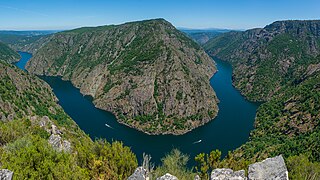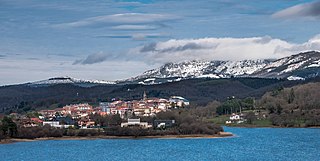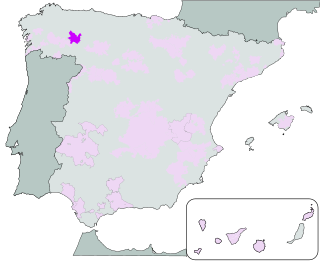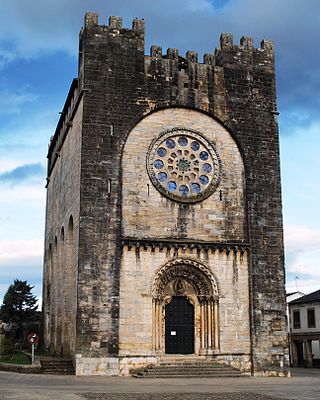
Ourense is a province of Spain, in the southeastern part of the autonomous community of Galicia. It is bordered by the provinces of Pontevedra to the west, Lugo to the north, León and Zamora, to the east, and by Portugal to the south. With an area of 7,278 square km., it is the only landlocked province in Galicia. The provincial capital, Ourense, is the largest population centre, with the rest of the province being predominantly rural.
Congosto is a village and municipality located in the region of El Bierzo. It is located near to Ponferrada, the capital of the region. The village of Congosto within the municipality has about 254 inhabitants.

The Sil is a river in León and Galicia, Spain, a tributary of the Miño. Its total length is 225 kilometres (140 mi). The source of the Sil is in the Cantabrian Mountains in the Leonese town of Villablino. It flows through the provinces of León and Ourense. The largest city on the Sil is Ponferrada (León). The Sil flows into the Miño upstream from Ourense.

Legutio is a town and municipality located in the province of Álava, in the Basque Country, northern Spain.

A Rúa is a mostly rural municipality in the province of Ourense, in the autonomous community of Galicia, Spain. It belongs to the comarca of Valdeorras. It is 101 km (63 mi) from the provincial capital, Ourense. An inhabitant of the area is known as a rués.

El Bierzo is a comarca in the province of León, Spain. Its capital is the town of Ponferrada. Other major towns are Bembibre and Villafranca del Bierzo, the historical capital.

Valdeorras is a comarca in the Galician Province of Ourense. The overall population of this local region is 25,500 (2019).

Bierzo is a Spanish Denominación de Origen Protegida (DOP) for wines located in the northwest of the province of León and covers about 3,000 km2. It borders on the provinces of Ourense, Lugo and Asturias in the north and in the south on areas of La Montaña, la Cabrera and La Meseta, in Léon. The area consists of numerous small valleys in the mountainous part and of a wide, flat plain . The DO covers 23 municipalities including the largest town of the area, Ponferrada.

Ribeiro is a Spanish Denominación de Origen Protegida (DOP) for wines located in the northwest of the province of Ourense, in the valleys formed by the rivers Miño, Arnoia, and Avia. It has an area of 30 km2 including 9 municipalities in their entirety and parts of four others.

Ribeira Sacra is a Spanish Denominación de Origen Protegida (DOP) for wines located in the south of the province of Lugo and in the north of the province of Ourense, in Galicia, Spain. It extends over the territories of 20 different municipalities that conform a zone and entity called Ribeira Sacra, which could be translated as "Sacred Shore". The vineyards are planted on the steep slopes of the valleys and canyons of the rivers Miño and Sil. The area acquired official Denominación de Origen status in 1996.

Valdeorras is a Spanish Denominación de Origen Protegida (DOP) for Galician wines located on the banks of the river Sil in the south of the province of Ourense,.

Portomarín is a municipality in the province Lugo, in the autonomous community of Galicia, Spain. It belongs to the comarca of Lugo. The town has a population of 2008 and an area of 115 km². It is one of the towns in the pilgrimage route known as the French Way, part of the Camino de Santiago.

Fabero is a small town in the Province of León and part of the «Castilla y Leon Autonomia» in north west Spain, near Galicia, with a population of about 5000 inhabitants.

Galician wine is Spanish wine made in the autonomous community of Galicia in the northwest corner of Spain. It includes wine made in the provinces of A Coruña, Ourense, Pontevedra and Lugo. Within Galicia are five Denominacións de Orixe (DO): Monterrei, Rías Baixas, Ribeira Sacra, Ribeiro and Valdeorras. In recent years, the region has seen a resurgence in its wine industry led by the international acclaim being received by the Rías Baixas region for its Albariño wines.

The Region of León, Leonese region or Leonese Country is a historic territory defined by the 1833 Spanish administrative organisation. The Leonese region encompassed the provinces of Salamanca, Zamora, and León, now part of the modern Spanish autonomous community of Castile and León. As is the case with other historical regions, and continuing with centuries of history, the inhabitants of the Leonese region are still called Leonese. Even today, according with official autonomous government, the historical territorial adjective is used in addition with the modern annexed territory, the rest of Old Castile, being "Castilians and Leonese".

Centro de Deportes Barco is a football team based in O Barco de Valdeorras in the autonomous community of Galicia. Founded in 1973, it plays in Preferente de Galicia – Group 2. Its stadium is Estadio Municipal de Calabagueiros.

Rioja Alavesa, officially Cuadrilla de Laguardia-Rioja Alavesa, in Spanish, and Biasteri-Arabako Errioxako kuadrilla, in Basque, is one of seven comarcas that make up the province of Álava, Spain. It covers an area of 315.83 km² with a population of 11,360 people (2010). The capital lies at Laguardia. It is part of a notable wine growing region.
Eloy Tato Losada was a Spanish-born Colombian prelate of the Catholic Church, participant of the Second Vatican Council and bishop of Magangué between 1969 and 1994.
Barco is the common Spanish word for ship. Barco may also refer to:

Ézaro is a parish part of the municipality of Dumbría, in the province of A Coruña, in the autonomous community of Galicia of northwestern Spain. It belongs to the comarca of Fisterra. It had a population of 600 inhabitants in 2019.




















